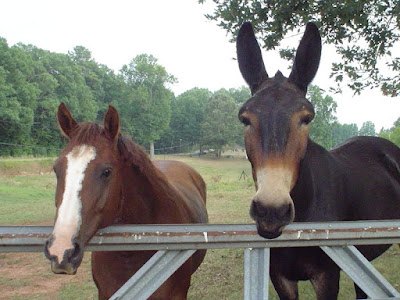We dedicate this episode of the podcast to Chapter 9 - Hybridism in Darwin's Origin of Species (OoS). We all agree that this chapter is one of the most challenging chapters to read in OoS. In this chapter Darwin force marches the reader through example after example of hybrids while simultaneously admitting his ignorance on why these creatures should exist.
It is not inherently obvious to the reader why they are being subjected to this catalog of biological anomaly and minutiae concerning pollination of orchids and other flowers but Darwin is adamant to share his knowledge, like a proud new parent inflicting others to look at numerous photos of their newborn. Darwin , early in Chapter I of OoS, argued against the notion that new species are formed through hybridization of existing species and we expected him to make that point in this chapter, but he never really does.
It seems that by the end of the chapter we are exhausted from Darwin's recounting various animal and plant hybrids and admitting his ignorance of sterility in hybrids but that does not dissuade Darwin from concluding he was right all along - “…the facts given in this chapter do not seem to me opposed to the belief that species aboriginally [emphasis added] existed as varieties”. Darwin stays on point.
We started off our discussion identifying our favorite hybrids. Josh first suggested mermaids as his favorite hybrid but James required he offer up a "real" hybrid.
 | ||
| Mermaids James grew up with in Florida |
 |
| 900 lb Hercules |
Sarah mentioned the Zedonk, a hybrid between a zebra and a donkey. This is another one of the hybrids that are created artificially in captivity. Few people realize that there are actually three different species of zebras - Grevy's, Plains and Mountain zebras - and each species has their own number of chromosomes. Grevy's zebras zebras have 46 chromosomes, Plains zebras have 44 and the Mountain zebra has 32 chromosomes whereas the donkey has 62.
 |
| Image from Carole Coleman |
 |
| A grizzly bear with her grolar cubs |
We discussed the most famous of all hybrids, the mule and how it is formed from the male donkey breeding with a female horse. Pictured below is a horse (left) and a mule (right) showing how the mule is often much larger than either of its parents, an example of Hybrid Vigor.
 |
| picture by Merle |
We noted that the mule hybrid can only be formed from male donkeys and female horses and rarely rarely formed from a male horse and female donkey. Sarah suggested that the reason the mule can only be formed from a male donkey and female horse has to do with the constraints of difference in gestation times between horses and donkeys. It turns out that horse gestation is 11-12 months whereas donkey gestation period is 11-14 months. There is a lot of overlap in gestation time between the two animals but it is an intriguing idea to consider it may influence non-reciprocal successful mating.
We introduced the idea of prezygotic isolating mechanisms and how they would evolve to prevent hybrids from being formed. Behavioral isolation is frequently seen in the complex displays and calls given by a variety of birds species and James mentioned the beautiful flashing patterns exhibited by the different species of fireflies. The image below shows the species-specific color and flash pattern of lightning bugs in Florida.
 |
| Go here to learn more about fireflies |
Josh introduced us to the sordid and dark world of duck mating behavior and male duck genital morphology. Here is just one example of the size and complexity of the male duck penis which has evolved in response to female duck vaginas. Female ducks have evolved elaborate shaped vaginas to avoid fertilization from other species of ducks.This interesting topic is covered nicely in this short article here.
Sarah spent some time explaining the intricacies of pollination and how pollen is actually greatly reduced multicellular structure that produces sperm - pollen is actually plant testicles. Plants evolve complex pollen grains, much like the extreme duck penis, to create reproductive barriers between species. The forms of inter-specific (between-species) barriers to reproduction would evolve because those individuals who are more discerning in their choice of mates would waste less time/energy fertilizing and producing those hybrid offspring which are often, at best, viable but infertile but more likely enviable. Often it is the female of the species that is the one who evolves the reproductive challenge for the male because she produces fewer, and often more metabolically expensive, gametes (eggs/ova) than her male (sperm) counterpart and therefore has more to lose if she errs on who she mates with than he.
 |
| Public domain image (created by the Dartmouth Electron Microscope Facility) |
Ultimately we conclude that hybrids exist because Darwin was correct in his model of speciation, that is new species derive from varieties of preexisting species (see Chapter 4 blog post) so they share many of the common genetic traits with their ancestral or closely related species. Surprisingly Darwin did not recognize that hybrids are his best argument against the special creation model of immutable species since one should not expect hybridism to occur between two immutably formed species that were specially created.
"That's a Wrap" & "Aces High" Kevin MacLeod (incompetech.com) Licensed under Creative Commons: By Attribution 3.0 http://creativecommons.org/licenses/by/3.0/

No comments:
Post a Comment